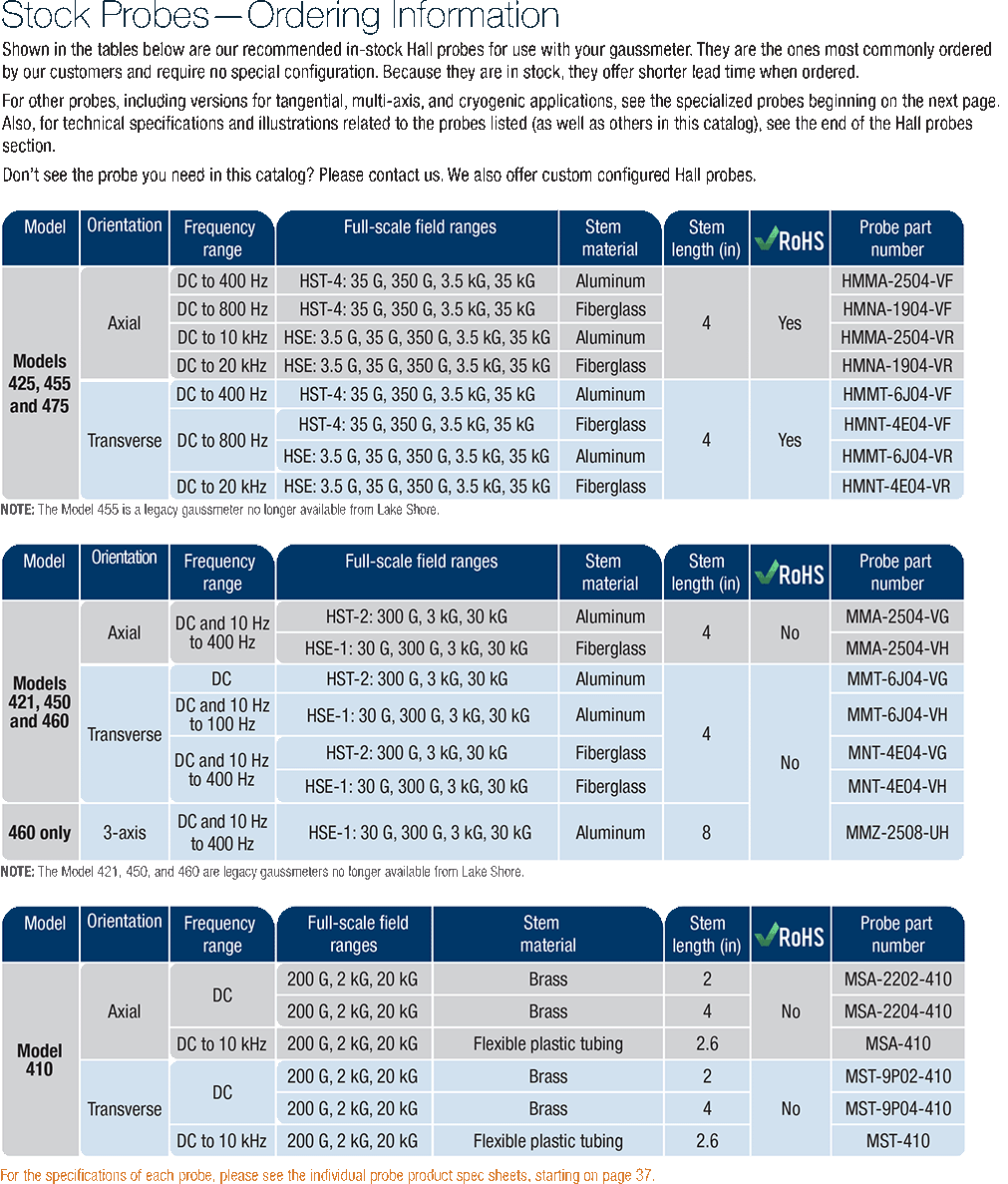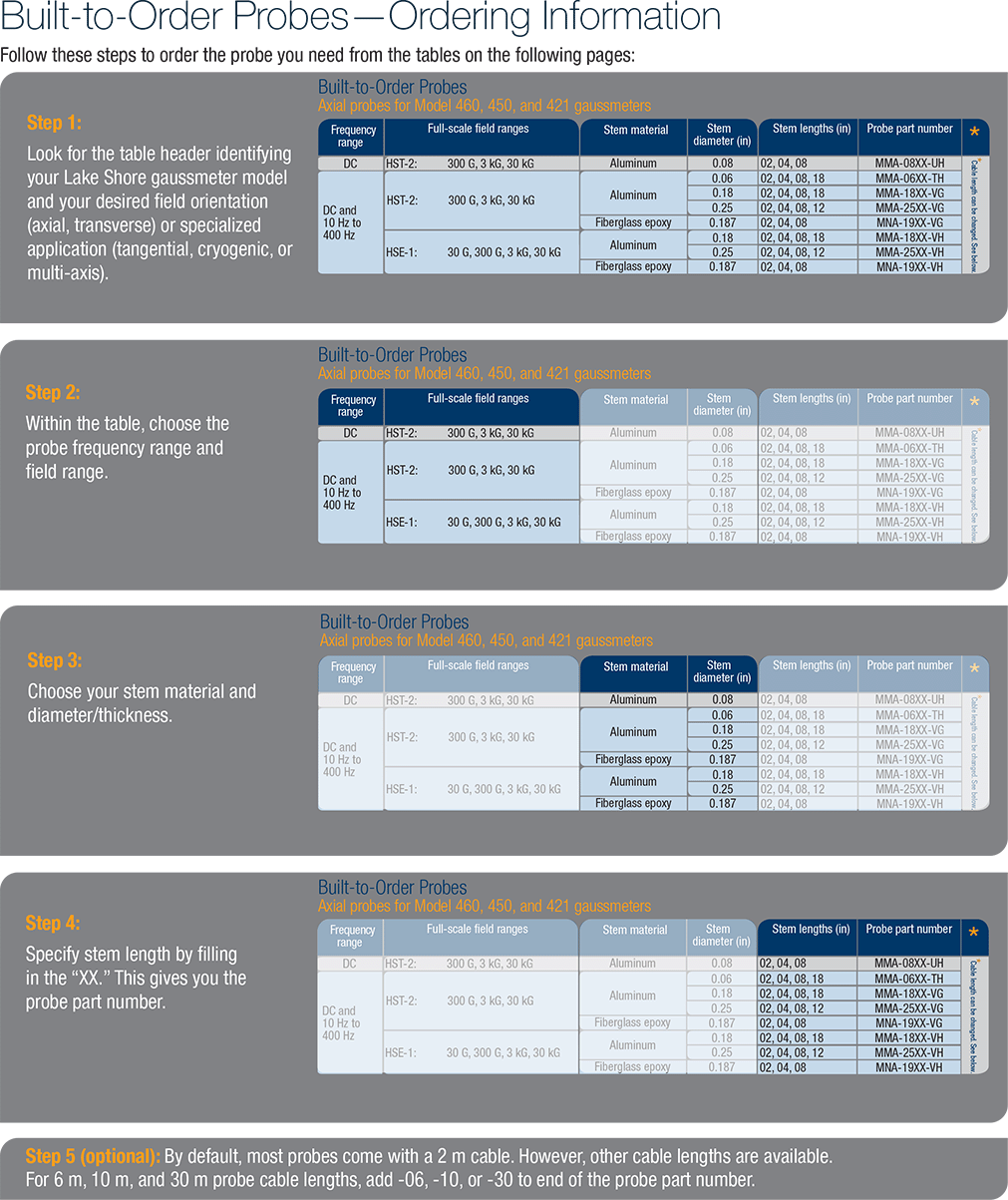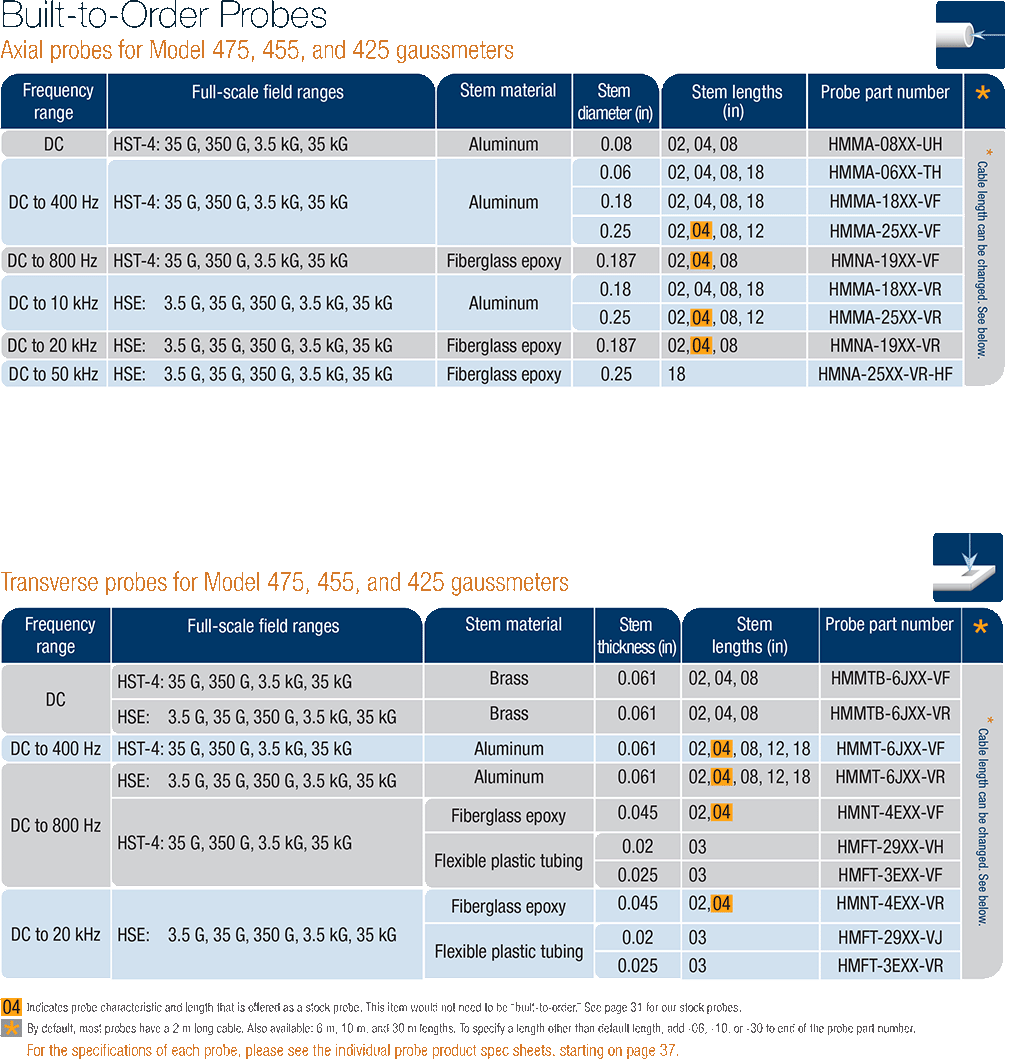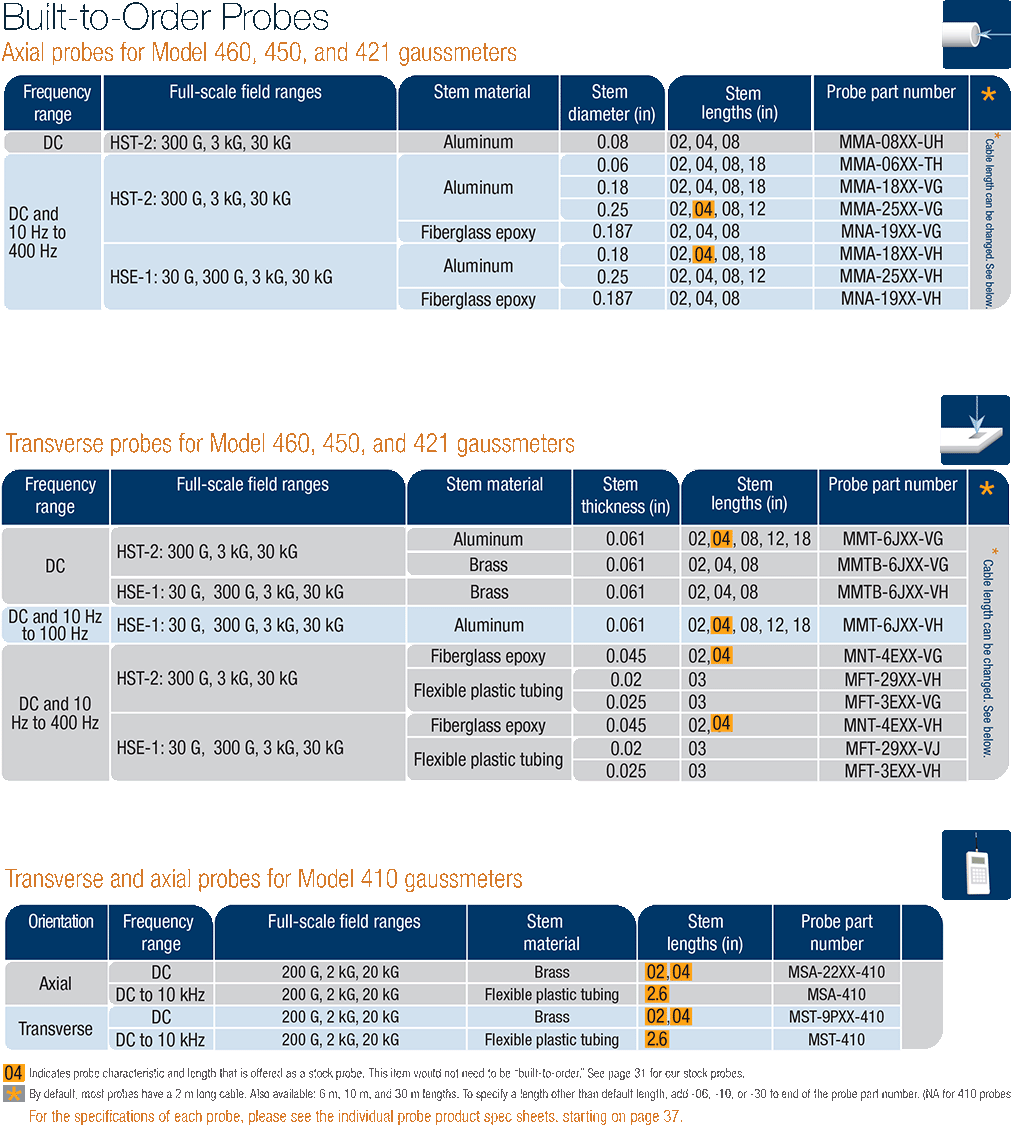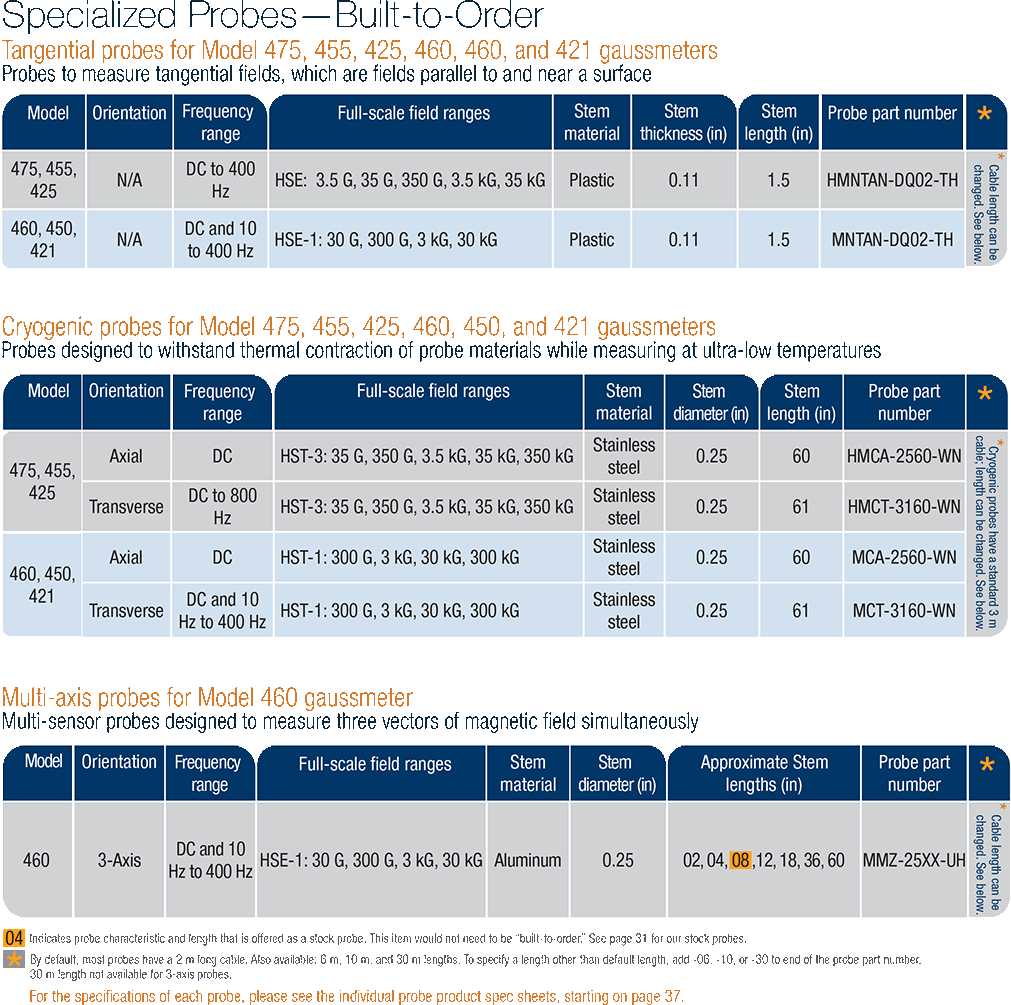Hall Probe Selection Guide
Characteristics to consider when selecting a probe
Proper selection of a Hall probe is probably the most difficult, and important, decision to make after choosing a gaussmeter. Using the improper probe could lead to less than optimal accuracy or, even worse, costly damage. Lake Shore offers a complete line of gaussmeter probes to work in a variety of magnetic measurement applications. Lake Shore probes are factory calibrated for accuracy and interchangeability. Lake Shore-calibrated probes feature a programmable read-only memory (PROM) in the probe connector so that calibration data can be read automatically by the instrument. If you have additional questions, contact Lake Shore and our experts can guide you through the selection process. Lake Shore can also custom design a probe to meet your specific application requirements.
- Choose a probe to match the application. Do not buy more accuracy, field range, or fragility than is actually needed.
- The thinner a probe, the more fragile it is. Try to avoid the temptation to select an easily damaged probe based on a possible, but not required, future application. For instance, avoid using an exposed-device probe such as a model MFT-3E03-type for
general field measurements. Once a stem or sensor has been damaged, the probe is not repairable.
- Metal enclosed probes, such as the MMT-6J08 and MMA-2508 types offer good protection to the Hall sensor. Brass stem transverse probes are even more rugged than the aluminum type probes, and offer the greatest amount of protection.
- Be cautious about using aluminum stemmed, transverse probes, such as the MMT-6J08-type, where AC magnetic fields are to be measured. Eddy currents in the stem material can affect reading accuracy. A superior choice for AC measurements would be the
MNT-4E04-type fiberglass-epoxy stem probes.
- Several stem lengths are offered for each probe type. User preference or test set-up dimensions usually determine the final selection. Longer stems are more susceptible to accidental bending (in many cases not catastrophic, but bothersome). Stem length
does not affect performance.
- Be aware of the differences in the probe “active areas” shown on the data sheet. A Hall effect probe will indicate the average field value sensed over that total active area. Thus, when measuring magnetic fields with a high gradient across
the sensor width, choose the smallest active area practical. Keep in mind the fragility rule (2).
- Lake Shore gaussmeter probes exhibit different ranges of magnetic fields over which they will provide valid readings. Check the specification sheet and the tables at the right for these usable ranges.
- If none of the standard probe configurations fit your needs, Lake Shore can provide custom probes to meet your physical, temperature, and accuracy requirements.
Contact Lake Shore with your special requirement details.
Magnitude
Typical Hall effect probes cover an operating range of 3 to 5 orders of magnitude. Operation beyond this field range requires some compromise in performance, often including higher noise or loss of resolution. Choosing the correct probe type ensures optimal performance in the desired measurement range.
High stability (HST-1, HST-2, HST-3, HST-4):
With a high field range of up to 350 kG1 (35 T), high stability probes are used when fields exceed the limit of other probe types. Their low field performance is slightly degraded with a minimum sensitivity of 50 mG (5 µT). HST probes are also inherently more temperature stable than other probes, and should be used when large temperature fluctuations are expected. They are offered in a variety of stem geometries.
High sensitivity (HSE and HSE-1):
High sensitivity probes are the most common for general-purpose field measurement. They operate effectively in fields up to 35 kG2 (3.5 T) with excellent sensitivity. At low fields, their sensitivity can be as low as 5 mG (0.5 µT). Convenient for many applications because of their relatively small active area, HSE probes are offered in the same geometries as HST probes.
1 350 kG with Model 475, 455 and 425, 300 kG range with Models 460, 450, and 421
2 35 kG with Model 475, 455 and 425, 30 kG range with Models 460, 450, and 421
Radiation effects on gaussmeter Hall probes
The HST and HSE probes use a highly doped indium arsenide active material. The HST material is the more highly doped of the two and therefore will be less affected by radiation. Some general information relating to highly doped indium arsenide Hall sensors is as follows:
- Gamma radiation seems to have little effect on the Hall sensors
- Proton radiation up to 10 Mrad causes sensitivity changes less than 0.5%
- Neutron cumulative radiation (>0.1 MeV, 1015 per cm2) can cause a 3% to 5% decrease in sensitivity
In all cases the radiation effects seem to saturate and diminish with length of time exposed.
Orientation
Getting to the field is part of the challenge in selecting a probe. Field orientation dictates the most basic probe geometry choice of transverse verses axial. Other variations are also available for less common, more challenging applications. Listed below are the standard configurations for HSE and HST probes.
Transverse:
Transverse probes, most often rectangular in shape, measure fields normal to their stem width. They are useful for most general purpose field measurements and are essential for work in magnet gaps. Several stem lengths and thicknesses are available as standard probes.
Axial:
Axial probes, usually round, measure fields normal to their end. They can also be used for general-purpose measurements, but are most commonly used to measure fields produced by solenoids. Several stem lengths and diameters are available as standard probes.
Flexible:
Flexible probes have a flexible portion in the middle of their stem, while the active area at the tip remains rigid and somewhat exposed. This unique feature makes them significantly more fragile than other transverse probes. Flexible probes should only be selected for narrow-gap measurement applications.
Tangential:
Tangential probes are transverse probes designed to measure fields parallel to and near a surface. The active area is very close to the stem tip. These probes are intended for this specific application and should not be selected for general transverse measurements.
| Usable full-scale ranges vs. probe type for Models 475/455/425* | ||
| HST-3 | HST-4 | HSE |
| — | — | 3.5 G |
| 35 G | 35 G | 35 G |
| 350 G | 350 G | 350 G |
| 3.5 kG | 3.5 kG | 3.5 kG |
| 35 kG | 35 kG | 35 kG |
| 350 kG | — | — |
| *Some ranges not available with the Model 425 | ||
| Usable full-scale ranges vs. probe type for Models 460/450/421 | ||
| HST-1 | HST-2 | HSE-1 |
| — | — | 30 G |
| 300 G | 300 G | 300 kG |
| 3 kG | 3 kG | 3 kG |
| 30 kG | 30 kG | 30 kG |
| 300 kG | — | — |
Frequency
Hall effect gaussmeters are equally well suited for measuring either static, DC fields or periodic, AC fields, but proper probe selection is required to achieve optimal performance.
Metal stem:
Metal stem probes are the best choice for DC and low frequency AC measurements. Non-ferrous metals are used for probe stems because they provide the best protection for the delicate Hall effect sensor without altering the measured field. Aluminum is the most common metal stem material, but brass can also be used. Metal stems do have one drawback: eddy currents are generated in them when they are placed in AC fields. These eddy currents oppose the field and cause measurement error. The error magnitude is proportional to frequency, and is most noticeable above 800 Hz.
Non-metal stem:
Non-metal stems are required for higher frequency AC fields and for measuring pulse fields. Fiberglass/epoxy is a common non-metal stem material, or the Hall effect sensor can be left exposed on its ceramic substrate. This provides less protection for the sensor. Eddy currents do not limit the frequency range of these non-conductive materials, but other factors may.
Please note: No gaussmeter probe type is suitable for direct exposure to high voltage.
Gradient
Probe selection would be easier if all fields were large and uniform, but most fields are limited in volume and contain gradients (changes in magnitude). Hall effect probes measure an average magnitude over their active area, making it necessary to understand the relationship between active area and field gradients.
Severe field gradients are always experienced as the active sense element is moved away from a permanent magnet pole, making it important to know the distance between the active area and probe tip. The distance between probe tip and active area is specified for axial probes, but is less easily defined for transverse probes.
Nominal active area:
HSE and HST probes have a nominal active area on the order of 1 mm diameter, which is useful for all but the most stringent applications. The measured field is the average of the active area, but without severe gradients, the measured value accurately represents the true field. Field mapping with standard probes is also practical if a mapping resolution of 1 mm or greater is acceptable.
Small active area:
HSE and HST probes with a smaller active area are also available from Lake Shore for measurements in severe gradients, or for high resolution mapping applications.
Probe durability
All Hall effect probes are fragile. The sensor, normally located at the tip of the probe stem, must not be bent, physically shocked, or abraded. It may be tempting to choose a probe with the thinnest transverse stem or smallest diameter axial stem; however, it is always best to choose the most robust probe that fits the immediate application. For example, the HMMT-6J04-VR (aluminum stem) is less prone to damage than the HMFT-3E03-VR (flexible stem), and the HMMA-2502-VR (1/4 in diameter aluminum) is more durable than the HMNA-1904-VR (3/16 in diameter fiberglass) with its exposed Hall sensor. Note: never fasten a probe stem to another object. If a probe is to be clamped, always apply the clamp to the handle.
Polarity of transverse probes
The output will be positive when the direction of the flux density vector is into the Lake Shore logo (i.e., the logo is towards the north pole).
Definitions
+B = Magnetic flux density vector (positive gaussmeter reading)
